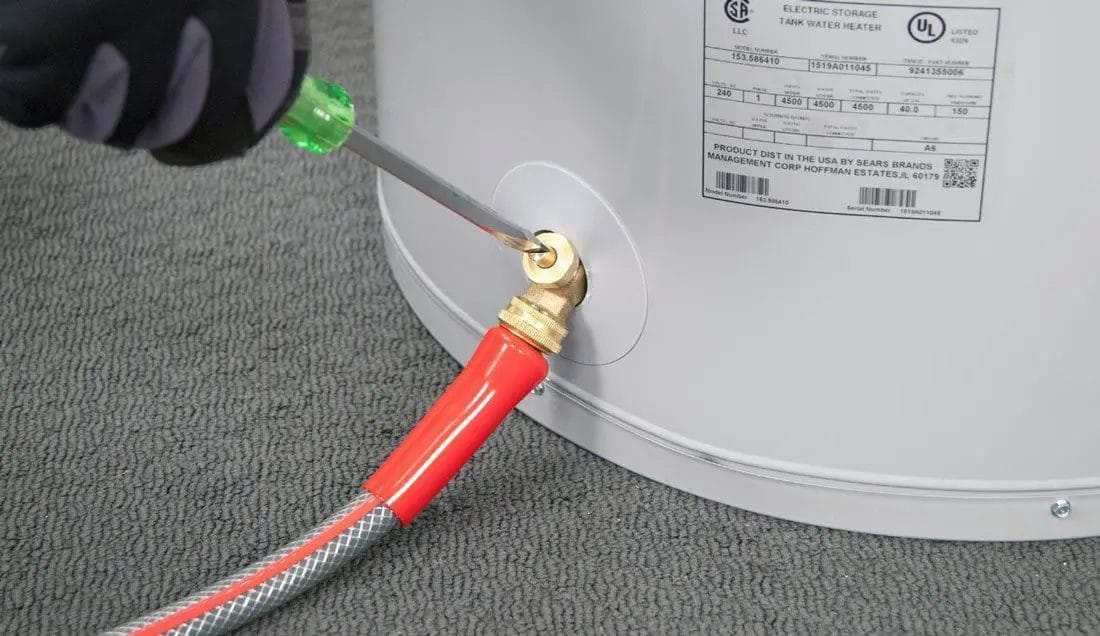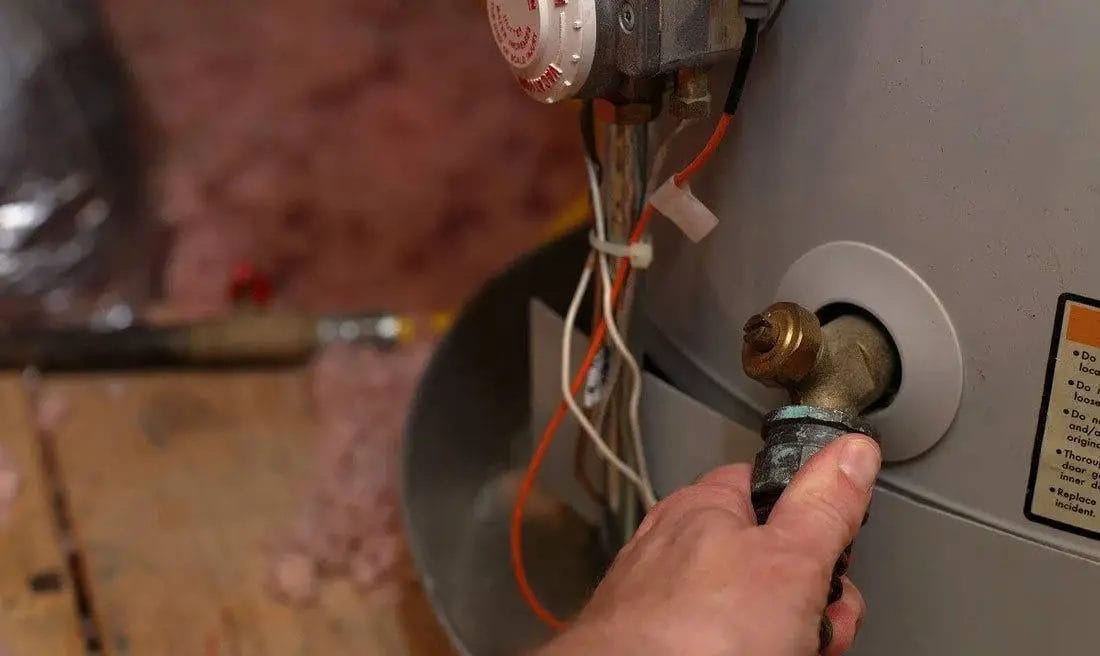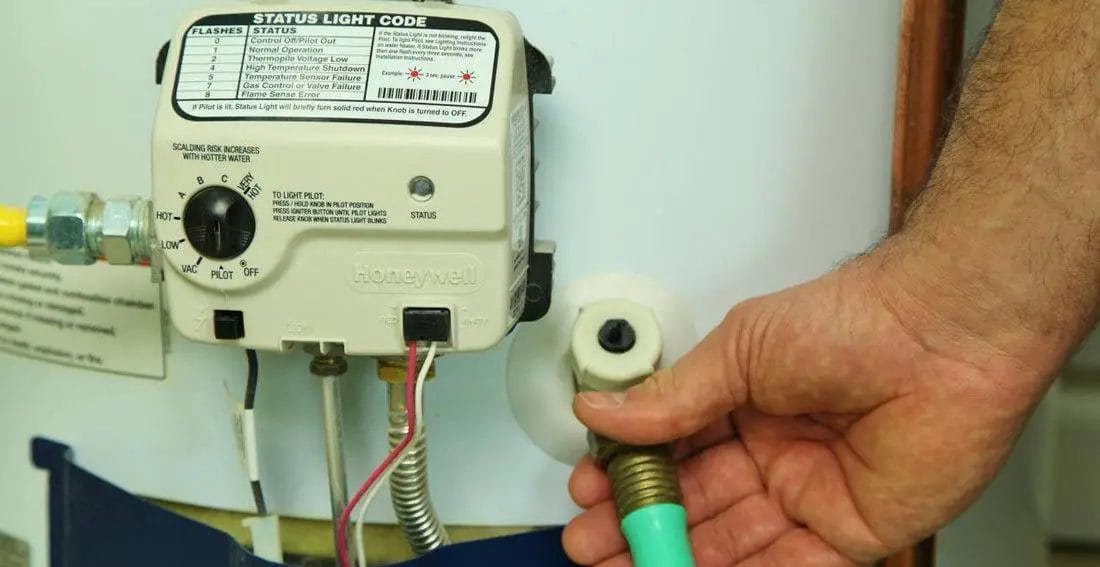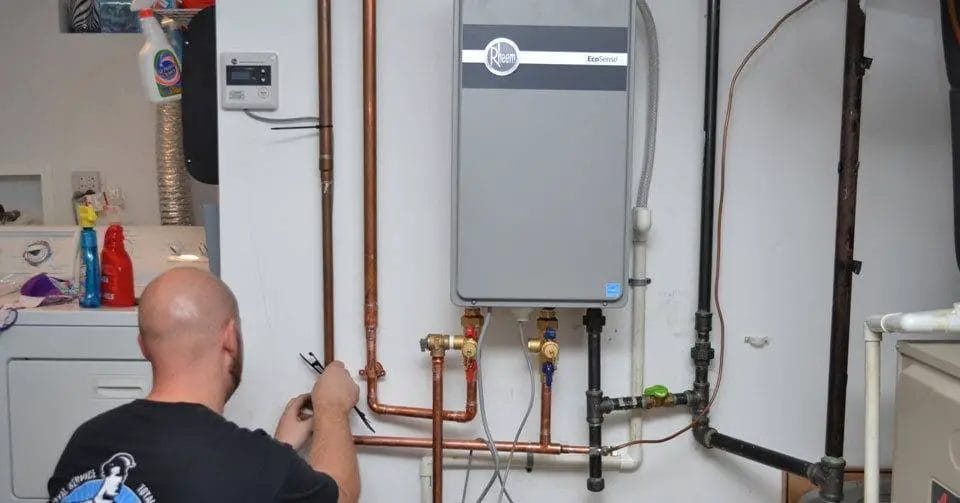Today’s topic is how to drain a water heater without drain valve. Water heaters have been creating relief for many households for years now. It is the most used household appliance, as well as the most neglected. Its function may seem irrelevant until it’s broken.
This is why it is essential to give your water heater the due maintenance it deserves. So, you have to drain it at least once a year. But what do you do when the drain valve goes bad?
After reading this how-to drain a water heater without a drain valve article, you will know what to do. Nothing can stop you from cleaning any sediment that may have clustered in your water heater, not even a faulty drain valve.
What is the Drain Valve of a Water Heater?

The drain valve is the valve located at the bottom of the heater in the tank-type heater. It functions by removing water from the entire system when draining or flushing the system.
How to Drain a Water Heater Without Drain Valve
Getting to drain out water from your heater when the drain valve is nonfunctional can be quite difficult. But there has to be a solution surely, especially when everything else is failing.

Here are the tools you will need and a step-by-step process of how to drain a heater without a drain valve.
Stuff You Will Be Needing
- Big bucket
- Self-tempering serrated insert
- Screwdriver
- Big bucket
- Rug
- Funnel
- Drill bit
- Manual drill
- Hosepipe
- Hacksaw blade
Step by Step process
Step One
Put off the heater’s main power supply, whether it is an electric or gas power source. If the water is still hot, allow it to cool before proceeding further to avoid being burnt or scalded.
Step Two
Remove the faulty drain valve and ensure that the area of the heater that supplies water to it is turned off. Also, ensure that the hot water valve is closed. If your heater comes with a plastic drain valve, put a self-tapping serrated insert to block the nipple, and unscrew it.
Better still, you can bore a hole in the drain valve using a manual drill. Do not use an electric drill to avoid electric shock, resulting from water drips when boring the hole.
If your heater nipple hole is made of brass, you can use a hacksaw blade to make a cross-patterned cut on it. Then, pierce through the cut using a screwdriver, and turn the screwdriver clockwise.
After that, you can now insert the garden hose into the opening and put the other end of the hose on your bucket to start draining. The rug will help prevent any form of water spillage on the floor.
Step Three
After draining, leave the T and P valve on to allow air dry the water on the inside. And now you are done.
Why You Should Drain Your Water Tank
Draining your water heater is part of its regular maintenance. As time goes by, our water heater accumulates dirt, and other sediments build up. Aside from dirt, the tank rusts and the corrosion also rests at the tank’s bottom, which, in most cases, can lead to clogging of the tank.
Click here to learn How to Install Tankless Water Heater.

This may not sound as unpleasant as it is, but have you ever boiled a pot of water with clusters of dirt? It is not just undesirable, but it also takes a long time to boil to your desired temperature. This is what happens with your water, causing you to waste more time and use more cost to run it.
Draining your water heater will help flush out these specks of dirt and build-up, and reduce any form of malfunction. Thus making it work better and more efficiently.
How to Drain a Water Heater Fast

Flushing your water heater is essential for proper functioning. Here is a step-by-step process on how to drain a water heater fast.
Step One
Shut off the heat source to your water heater. For gas water heaters, the power source, which is the thermostat, is usually close to the tank’s bottom. For an electric heater, to turn it off, you have to find the home breaker box and turn off the switch that supplies power to the heater.
Step Two
Allow the water tank to cool to avoid working with boiling water. To enhance the process, turn on your kitchen sink hot water tap. Because we have turned off the heater’s burner, draining the hot water through the kitchen tap will cause cool water to replace it.
Leave the kitchen faucet on during the entire flushing process. This will prevent vacuuming in the lines while draining the hot water.
Step Three
Attach a hose to the drainage valve and ensure the other end of the hose is routed to a bucket or any other place where the water can lead to the sewer or street. If your water heater is located in the basement, you should acquire a pump to get the water from the basement to the ground floor.
Step Four
Turn off the cold water inlet valve located above the tank, so you can do it without turning off the whole household water supply. Better still, you can turn off the water from the point where water enters the house. So, you must discover these valves before you start the entire flushing process.
Step Five
Open the spigot and start draining. But, make sure the other end of the hose is channeled outside or leads to a bucket. But if it is in a basement, you need to get a water pump to enable you to pump the water from the basement to the ground floor.
How to Flush a Water Heater

The right time to flush your water heater is when the tank is empty, when it’s done, or almost finished draining. Here are the steps on how to flush a water heater.
Step One
Open the cold water inlet valve, let it flow into the tank for fifteen to twenty seconds, then turn it off. Doing this will help bring up the sediments lying on the tank’s bottom.
After that, check the hose attached to your drain valve and check the water sample coming out. If the water is dirty, you have to restart the entire flushing process until the water coming out of the heater is clean.
Step Two
After clean water starts coming out, turn off the drain valve and open the water valve. Then, disconnect the hose and allow the tank to be refilled.
Step Three
In the course of draining out the water, air must have been trapped in the system. So to remove the air from the water lines, open the hot water faucet. The air will escape through the faucets, and when water starts flowing out of the faucet steadily, you can turn it off.
Step Four
Now that everything is set, you can now turn on the burner again. Do this when the tank is full or half full, at least because turning it on sooner could result in damage. Since the water is cold, the burner will kick start immediately.
If you have an electric heater, turn on the breaker to set the heat again. If it’s done, you should feel a temperature rise in the faucet within the next thirty minutes.
How to Drain an Electric Water Heater

To drain your electric water heater, take the following step properly.
The first step on how to drain an electric water heater is to turn off the power button of the heater. To do this, you have to disable the circuit breaker or fuse that powers the system.
Next, turn off the water source that supplies the heater with water. You can find this valve at or close to the cold water inlet pipe on the heater’s top. To turn it off, turn the clock clockwise. If you cannot find the valve, a second option is to put off the main water supply valve to the house.
Now you are ready to drain. Locate the drain cock at the heater’s bottom. It is usually colored silver or brass and has a threaded end. You can put a bucket under the drain or attach a garden hose.
Open the pressure and temperature valve to relieve the pressure from the tank. You can find it on the side of the top of the heater. To open it, flip the lever on it upwards.
Now is time to drain the water in the tank. You can do a partial or total drain of the tank. For a partial drain, let in some gallons of water into the hose. But for a complete drain, you will have to empty the tank.
When the draining is complete, close the temperature and pressure (T&P) valve and the drain valve. After that, switch the water heater power supply back on.
How to Replace a Water Heater Drain Valve Without Draining the Water
Replacing the water heater drain valve without draining your water heater is not as difficult as you may think.
Draining your water heater is possible if the drain valve is clogged. If this happens, installing a ball valve is the best answer to a clogged drain valve.
Hot Water Tank
A hot water tank or boiler is a heat exchanger that heats potable (drinkable) water. Heating water is one of the most common and important ways to stay warm. People rely on their hot water tanks when it gets too cold outside. They provide not only heat but also warmth.
A hot water tank is a system that helps provide heated water to your home or business. A hot water tank will typically be made with two types of metal – copper, and steel. It will usually store up to 50 gallons of heated water in the tank’s insulated containers. A water heater or furnace heats the cold liquid in a hot water tank to be ready to use.
Generally, hot water tanks have the purpose of storing hot water to provide a continuous hot water supply. This product has been used in residences worldwide for over a century. The traditional design of a hot water tank is cylindrical and made of steel or copper. The tank is insulated with a heating element that heats the water even when not in use.
Gas water heater installation
A professional should install a gas water heater to ensure their safety and home safety. The installation process is easy if someone knows what they are doing. It can be done in two days, so most people will not need to take time off work. Gas water heater installation requires consideration of several factors.
First, the size of the home should be considered. In a household with multiple people, a water heater that can provide hot water to everyone is best. Getting a smaller model might be cost-effective if only one person is in the household. Gas water heaters can be set up in a relatively simple process. It can be done by following the steps below.
– Identify the location where you want to install your gas water heater
– Make sure that it is not located near any potential sources of flame or heat
– Turn off the gas and shut off all water supply lines to the existing plumbing fixture
– Remove any old gas connections or valves from the area
– Connect the new piping for your gas water heater to a nearby cold water line, and the gas line, remembers to have all the parts and tools for installation, including elbows, connectors, straight fits, unions, and clamps. Connect each connection with metal-to-metal using a pipe clamp.
Dishwasher drain hose
Dishwashers typically come with a drain hose, which should be connected to the sink’s drainpipe. A dishwasher needs water to run down the drainpipe and into the dishwasher. A dishwasher drain hose allows water to flow from your kitchen sink into your dishwasher.
An appliance’s drainage pipe is connected to (usually under) the pipe connected to the kitchen sink. Unlike a washing machine or clothes dryer, a dishwasher does not require electricity. As soon as you connect the drain pipe and load the dirty dishes, the dishwasher starts automatically.
What is a hose bib pressure relief valve?
A hose bib pressure relief valve is a valve that is installed on the water supply line for outdoor hose bibs. A pressure relief valve protects the water supply from being over-pressurized and bursting. Sometimes water pressure can be too high, leading to a burst pipe. The pressure relief valve will help protect your pipes from bursting. The valve opens up when the faucet is turned on to prevent future accidents or bursts.
What is a gate valve?
In valve design, the gate valve opens and closes by rotating sideways. They are also called swing valves. Gate valves are efficient for controlling fluid flow and pressure in piping systems. They are typically used when there is over one position to control fluid flow.
The use of throttles in the valve body allows for easy adjustment of flow rates during regular operation. Since this type of valve requires external power, other classes have largely replaced it. Chemical plants, food processing plants, and oil refineries use gate valves and heating and cooling systems.
What to do if your water heater has no drain valve?
Step 1: Turn off the power to the water heater. Suppose you’re not sure how then find the breaker in your basement or garage.
Step 2: Find a flat surface like a workbench or patio. Place a bucket under the drain valve and open it up by turning it counterclockwise.
Step 3: Take a wrench and loosen the drain valve by turning it counterclockwise so water can flow out of your tank and into the bucket. You may not need to use this step if there is enough pressure in the tank to make water flow out of your tank and into the bucket.
How do you drain a water heater without a hose?
A quick answer is to turn off the circuit breaker to the unit, let it cool down, and then open up a faucet that drains water from inside. Another way is to use a garden hose to attach it to the drain valve.
-If you have a garden hose, attach it to the drain valve on the side of your water heater.
-Otherwise, turn off your circuit breaker for safety and wait for it to cool down before opening up a faucet that leads inside of it.
What is the size of your tankless water heater?
When looking for a tankless water heater, there are two main considerations: size and energy efficiency.
Water heaters that do not have tanks are smaller because they only supply hot water on demand. They also have a lower standby heating capacity and use less energy to deliver the same amount of hot water as a traditional model.
What if your water heater will not drain?
What if you wake up in the morning, turn on your hot water tap to take a shower, and it doesn’t drain? Perhaps you are wondering, “What did I do wrong?” Many things can cause your water heater to stop draining.
1. You may have a clogged drain pipe located near your water heater. If this is the case, you’ll have to call a plumber.
2. The problem may lie with your cold water supply line and not the drain at all. So before you connect it back up, make sure to check it for leaks or damage first!
3. There may be a blockage in your vent line which needs to be removed by a professional technician before you can continue using your water heater again.
How long does a tankless water heater last?
Tankless water heaters have the potential to last for decades. They use less energy than traditional tank water heaters and are more efficient. Certain things can happen to tankless water heaters that might shorten their lifespan:
If you don’t maintain them and keep them running smoothly, they won’t last as long as possible.
If you don’t maintain the gas line or venting system, this can cause damage.
How does a tankless water heater work?
A tankless water heater is a type of water heater that typically heats the water as it comes in from the cold-water pipe. The hot water is stored inside a tankless unit and is heated to the desired temperature, which can be regulated by adjusting the water flow.
A tankless heater is more efficient than traditional storage heaters because it heats up only what you need when you need it. It does not store hot water to be used later, as a conventional storage heater does. This means that when you use hot water, it has to be heated up on the spot and for each new use, making this type of heating system more expensive to run.
How To Drain A Water Heater Without Drain Valve Video:
Frequently Asked Questions (FAQs)
How Often Should You Drain Your Water Heater?
Why Is My Water Heater Drain Valve Leaking?
Can the Water Heater Drain Valve Be Replaced?
How Do I Know That My Drain Valve is Clogged?
Should I Install a Drip Pan Alongside My Water Heater?
Wrap Up!
Having gone through the process of how to drain a water heater without a drain valve, you can now enjoy a How To Drain A Water Heater Without Drain Valvesediment and dirt-free water heater with or without a drain valve.
However, most people often forget to ensure their water heater is drained and maintained regularly. But this is essential for your water heater to function effectively.
Also, draining your water heater tank may seem like a simple task, which it probably is. But most people have ended up flooding their house or basement trying to do it. So you must observe every preventive measure and follow the steps carefully.
Sarah J. Gregory
352 Hershell Hollow Road
Anaheim, CA 92805






